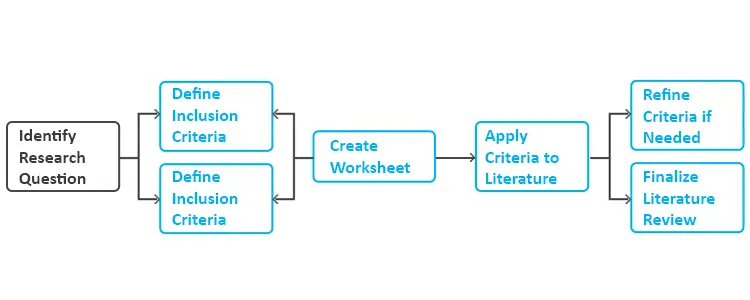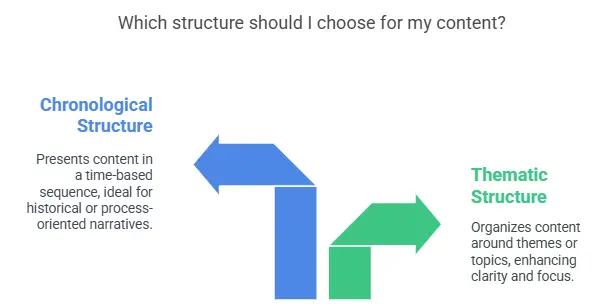What is a Good Way to Start a Research Report? (2025 Guide)
Struggling to start your research report? Learn how to craft a strong introduction with examples, templates, and USA-specific tips. Download our free ...
Having difficulty with your literature review? You're not the only one facing this challenge. More than 60% of university students experience trouble crafting an engaging literature review while integrating information from various sources to develop a new or enhanced perspective on a topic. A literature review is a comprehensive study that critically analyzes existing research papers and documents on a particular topic.
Literature reviews effectively identify gaps in existing papers, justify the narrative and ideas of the paper with strong arguments, and explore its weak points to justify the need for further research. They also showcase the researchers' expertise in specific topics. So, if you are looking to write a literature review and struggle to understand how to start and what the right way of writing is, then this is for you. Everything you need to know before writing a literature review will be covered in this post.
The literature review summarizes different research about a topic through analysis to detect regular patterns as well as missing information and universal connections. Literature reviews surpass annotated bibliographies because their purpose involves critical assessment of research content as opposed to straightforward investigation of source materials. An annotated bibliography includes basic definitions, yet a literature review presents the research sources as a unified narrative that demonstrates their value in advancing understanding of the subject.
Literature reviews come in various forms, and the academic discipline influences the type of essay you produce and whether you are a researcher preparing the review for a PhD, aiming to publish in a journal, or completing a coursework assignment. It can be an impressive way to start your research paper. Specific factors influence how to write a Literature Review. A literature review for an undergraduate course will not be as thorough as the review needed for a PhD dissertation. Here is a brief of various literature review types:
Example: What challenges did you face when learning to read in a second language?
Example: A systematic review: Nicotine effects on exercise performance and physiological response in nicotine-native individuals.
Example: Efficacy of cognitive-behavioral and pharmacological treatments for children with social anxiety
Producing a literature review can be quite challenging! A literature review summarizes existing research or papers. Due to its intricacies and word count limitations, many students find writing a literature review difficult. The eight Steps to write a literature review will guide you in crafting an engaging research paper. Stay focused on these eight steps and approach your writing systematically.
Since the writing of a literature review has a limitation on word length. Therefore, you must include the most important points. Before you begin the writing process, clarify the scope of your review. Ask yourself specific questions to determine the most effective methodology for your review. Here are a few questions.
Asking these simple questions before you dive into the writing process will help you draw a clear roadmap for your review. For instance, you have to cover the impact of social media on mental health among adolescents. You would likely have restricted your studies and research to the fields of psychology and communication in recent years.
Inclusion/Exclusion Criteria Setting Process

The literature review delivers convincing academic and research documents. A literature review functions with purposes that surpass study summaries since its main goals are to provide background to current academic work, alongside research gaps analysis, and suggest possible solutions. The author must perform in-depth research to collect vital information as well as multiple sources of arguments. How it helps:
Selecting Relevant Databases and Search Engines: Different databases specialize in different types of information. For academic literature reviews, you'll primarily focus on scholarly databases.
Refining Searches with Boolean Operators: Boolean operators are words like AND, OR, and NOT that you use to combine your keywords and make your searches more precise.
As you have chosen topics in different fields, the review must be authentic, and for that, it must be efficient; hence, you must evaluate the sources you used. This evaluation makes the information credible and sustainable. This means looking into the authority, accuracy, currency, relevance, and the purpose of a source, or the bias that it may hold. However, do check to retain author credentials, relevance to the subject, and reputation of the publication.
1. Peer-Reviewed Journals: Scholarly publications’ experts examine the article to ensure the quality and accuracy of the report. It helps the writer to understand how to write a Literature Review efficiently.

2. Author Affiliations: This is where the author's research took place. It helps the readers identify the institution that provides the support and resources to the author. Affiliations of the renowned publications increase the trust of the readers in the literature review.
3. Citations in recent studies: Citation often helps the author to eradicate the chances of plagiarism, if they have used the work of other writers or researchers. The literature review includes the findings and studies of recent times, and therefore, you must use the citations to acknowledge the source of information. It will enhance the credibility and support your claims by providing the evidence.
Zotero
Use Zotero, an open-source reference tool, to gather, arrange, cite, and distribute research materials. Saving references from online sources and library catalogs is beneficial. Include PDFs and other files, annotate them, and make bibliographies using several citation formats.

Spend enough time reviewing literature, both past and present. Before you start writing your research paper, you must address thematic and research-gap analysis within the existing literature. This will help you identify areas that are under-researched or where contrasting evidence requires more attention. Look out for topics, questions, or themes that keep recurring in literature across sources. This way, you can group the literature in clusters with some meaning.
Uncover neglected demographics: certain marginalized populations have not been sufficiently studied. Often, these groups have not been the subject of research and feel neglected. It is vital to recognize their needs for shaping relevant policies and practices.
A thesis statement encapsulates the essence and main argument of the literature review. The statement should be concise and clear, and guide the reader about the research paper. With the thesis statement, the writer clearly states their stance. Now, how to write a Research Paper thesis statement? Once you have developed the arguments and evidence for your reviews, you should return to the main points to refine a thesis statement covering the review's summary.
Keep a few things in mind to craft a complete thesis statement:
Here is a weak and strong thesis Literature Review Example, learn what to avoid and how your thesis should be.
While you set the literature review structure, you have two options: Chronological or Thematic.

Step 7: Write the Draft
If you are wondering how to write a Research Paper of a literature review, use the following structure:
Step 8: Revise & Edit
Review your finished research paper to ensure no errors exist before its official submission. Failure to review your work proves unadvisable because multiple errors could exist that you failed to detect. Thoroughly proofread your writing to make it both easier to understand and more effective in its communication. Check how transition statements like " however and similarly" work in your text. The work should be presented in passive voice to make it more effective. Consider hiring someone or asking a peer to review your writing; their fresh perspective can help identify flaws more effectively. Once mistakes are identified, proceed with the necessary edits. Editing involves making specific changes to correct grammatical and spelling errors. You can use the tool Grammarly to identify and rectify the mistakes and errors.
Download Grammarly: https://www.grammarly.com/desktop
Tap on the link and download Grammarly to take the free trial and enhance the quality of your paper.
Mistake 1: Over-relying on outdated studies
A major drawback in writing literature reviews exists when researchers depend too heavily on outdated studies. The field of knowledge transforms at a fast pace, particularly within rapidly evolving domains, including medicine and technology; thus, previous year foundational studies may fail to provide current applicable knowledge. Examining US tech trends requires focusing on sources published between 2018 and 2023. Your review will accurately present current discoveries combined with evolutions in industrial practice and new challenges through this approach. Recent studies enable you to strengthen your arguments while proving your deep knowledge of contemporary research outcomes within your topic domain.
Mistake 2: Ignoring contradictory findings
Research that shows results against your hypothesis often gets ignored by some scholars as a standard mistake. A thorough literature review demands inclusion of contradicting evidence, which proves both your analytical thinking abilities and the multifaceted dynamics of research fields. Your analysis risks losing credibility when you decide not to incorporate studies that present alternative views. Embracing research opposed to your viewpoint serves to make your argument segment stronger. Including this approach strengthens your discussion because it demonstrates how extensive the current knowledge base is, which enables you to solidify your arguments and highlight unexplored research areas.
Bringing together existing studies through critical analysis remains fundamental during literature review research writing. Through gap identification combined with theme analysis and enlightened synthesis of previous studies, researchers produce significant insights that benefit their discipline. Using the defined steps of scope definition alongside source evaluation, gap identification, and systematic review writing will help you create a higher-quality exploration. Research incorporating the latest studies, as well as addressing conflicting findings, creates robust reviews that serve as the foundation for upcoming research initiatives.
Beginning a literature review requires incorporating the findings, arguments, and evidence from previous research papers. Writing a research paper involves analyzing earlier and current studies. The literature review should commence with an overview that encapsulates the main arguments found in earlier works on the same subject.
Here are the five steps to write a literature review:
1. Cite: All referenced literature in your review should contain appropriate citations. The citations not only honor primary authors but also strengthen the credibility of your work.
2. Compare: Research how multiple studies connect to each other. Drill down into the various research works through detailed analyses of their methodologies and findings, and assessment of their final results to pinpoint matching and diverging elements.
3. Contrast: Demonstrate the dissimilarities between methods and results found in published articles. The analysis helps explain multiple findings while resolving overlapping, contrasting views in the field.
4. Critique: Analyze the existing literature through both positive and negative assessments. Analysis should explore the methodological constraints and inherent biases and their effect on research outcomes.
5. Connect: Use researched works to connect findings across studies. Use multiple research studies to build a complete knowledge base about the topic while highlighting unexplored areas that need additional study.
A literature review consists of three key parts: the introduction, the main body, and the conclusion.
1. Introduction: This section sets the stage for the review by presenting the research topic, its significance, and the objectives of the review. It provides context and outlines the scope of the literature examined.
2. Main Body: This portion of the analysis presents an extensive review of different research, theoretical frameworks, and study results regarding the subject matter. It displays both current research tendencies and academic arguments, along with recognized areas that need investigation to achieve an extensive comprehension of known information and theories.
3. Conclusion: The conclusion draws together essential points from the work before discussing how the research findings affect understanding and proposing research guidelines for the future.
While you are creating a dissertation, research paper, or thesis, you will have to conduct a literature review in order to place your research within the existing knowledge. The primary purpose of the literature review is:
Subscribe now!
To our newsletter for latest and best offers